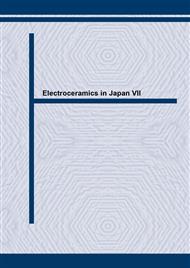[1]
K. S. Nanjundaswamy, A. K. Padhi, J. B. Goodenough, S. Okada, H. Ohtsuka, H. Arai, J. Yamaki, Solid State Ionics, 92 (1996), p.1.
Google Scholar
[2]
A. Yamada, S. C. Chung and K. Hinokuma, J. Electrochem, Soc., 148 (2001), p. A224.
Google Scholar
[3]
A. S. Andersson, J. O. Thomas, B. Kalska, and L. Haggstrom, Electrochem. Solid State Lett., 3 (2000), p.66.
Google Scholar
[4]
S. Y. Chung, J. T. Bloking, and Y. M. Chiang, Nature Mater. 2 (2001), p.123.
Google Scholar
[5]
S. Yang, P. Y. Zavalij, and M. S. Whittingham, Electrochem. Comm., 3 (2001), p.505.
Google Scholar
[6]
Z. Chen and J. R. Dahn, J. Electrochem. Soc., 149 (2002), p. A1184.
Google Scholar
[7]
T. Kudo, Y. Ikeda, T. Watanabe, M. Hibino, M. Miyayama, H. Abe, and K. Kajita, Solid State Ionics, 152-153 (2002).
Google Scholar
[4]
∆: LiFePO4-Carbon mixture 10-2 10-1 100 101 101 102 Specific Capacity, Q / mAhg -1 Current Density, I / Ag -1 LiFePO4/Carbon composite LiFePO4-Carbon mixture Nb-doped LiFePO4.
DOI: 10.1021/acsami.6b10594.s001
Google Scholar


